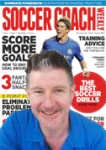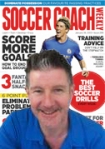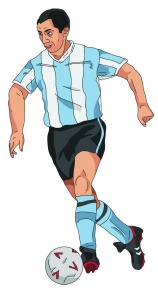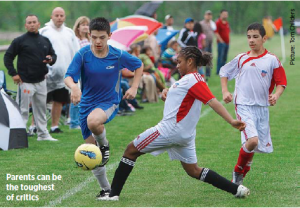Filed under: Dave Clarke, Soccer Coaching, Soccer Fitness, Soccer News, Soccer Refereeing, Soccer Skills, Soccer Team Management, Soccer Training | Tags: aggressive, coaching style, problems, Soccer
 I think all of us have a dark side that turns us into critics. Some people can be more critical than others, but if you’re on the receiving end you have to close your ears to the comments and just let the critics get on
I think all of us have a dark side that turns us into critics. Some people can be more critical than others, but if you’re on the receiving end you have to close your ears to the comments and just let the critics get on
with it.
I was at a coaching session last week and all around me coaches were being critical. Rather than write the session down and create something new from it, they just wanted an excuse to say “I’m better than you”.
But it’s not just true of coaches. Working with grassroots teams I tend to hear criticism constantly and a lot of it comes from the parents at the side of the pitch. If their son or daughter has not played well, they think the coach hasn’t been doing his job properly. If their son or daughter is substituted, the coach hasn’t a clue what he’s doing.
And on it goes. Remember, criticism is easy to make but your achievements are not. And it’s easier to deal with criticism when you realise the reasons behind it. Criticism from parents is often a tool to defend their children and to defend themselves in the face of other parents with higher achieving kids – it’s not an attack on you as such but it can be hard to ignore.
You are doing a great job so don’t let them put you off. It is because you have given up your time and taken on the role of coach that you have been thrust into the limelight and unfortunately a lot of people will resent your position of importance.
When I first started coaching I remember that one of my teams went through a sticky patch in the middle of the season, having started out with four straight wins. After one game a parent came up to me and told me that he had spoken to a few of the other dads and they had decided my tactics were wrong.
I was taken aback and rushed home to go through my notes and think about what they had said. My tactics hadn’t changed but the players were on a steep learning curve and some aspects of their play were just beginning to come through. At that time I felt quite nervous about the score in games – not like now, when I look at how well the team played before I even think about the score.
In attacking me the dads had come up with reasons why their kids hadn’t won the game, but it was their problem, not mine. Now that I understand why people criticise, I no longer feel nervous about what parents think of me. Once you realise why people criticise you’ll deal with it much better too.
Filed under: Dave Clarke, Soccer Coaching, Soccer Fitness, Soccer News, Soccer Refereeing, Soccer Skills, Soccer Team Management, Soccer Training | Tags: abuse, parents, referee, shouting, Soccer
This is exactly the kind of thing that happens more often than it should in youth sport. Get the parents of your players to watch it and make them realise how awful they can appear…
https://www.youtube.com/watch?v=kRqi0M_V9IM
Filed under: Dave Clarke, Soccer Coaching, Soccer Fitness, Soccer News, Soccer Refereeing, Soccer Skills, Soccer Team Management, Soccer Training | Tags: alf, Ardiles, coerver, development, Football, galustian, japan, maradona, messi, ossie, Soccer, World Cup, youth
 As a young player Ossie Ardiles was smaller than the other boys around him so he wouldn’t pass the ball much – he would just dribble and dribble and dribble. Much like Maradona and Lionel Messi. His brother called him Piton, the snake. In this exclusive interview Soccer Coach Weekly’s David Clarke spoke to him about youth soccer, Argentina legends and Japanese success
As a young player Ossie Ardiles was smaller than the other boys around him so he wouldn’t pass the ball much – he would just dribble and dribble and dribble. Much like Maradona and Lionel Messi. His brother called him Piton, the snake. In this exclusive interview Soccer Coach Weekly’s David Clarke spoke to him about youth soccer, Argentina legends and Japanese success

Most recently Ossie Ardiles was the coach of Machida Zelvia in the second tier of the Japanese J-League, but a 23-year coaching career has taken the Argentinian World Cup winner around the world. As player-manager he introduced a flamboyant style of football to Swindon Town in his first coaching job, achieving promotion to the top flight in 1990 (only for the FA to strip the club of this honour for off-the-field irregularities).
Three years later he took West Brom to Division One and later made headlines in the Premier League with a cavalier Spurs side notable for fielding five forwards. After relocating to Japan he was named J-League Manager Of The Year in 1998 for his work with Shimizu S-Pulse. He won the first stage of the J-League with Yokohama F Marinos in 2000 and the Emperor’s Cup with Tokyo Verdy five years later.
He has also enjoyed spells managing clubs in Mexico, Argentina, Paraguay, Croatia, Israel and Saudi Arabia, giving him a truly global view of the game – but wherever he has coached, he has always brought a certain Ossie style to the job.
DAVID Having coached four clubs in England, is the Premier League the best in the world?
OSSIE“The Premier League is certainly the most watched and the richest – and it attracts the best players in the world because of these reasons. Yes, I would imagine it’s the best league in the world.”
 You have enjoyed several stints in Japan. What is it about the Japanese game that attracts you?
You have enjoyed several stints in Japan. What is it about the Japanese game that attracts you?
“The J-League started in 1993 and I came soon after. I think the J-League is and was the model of how professional football should be marketed for the fans. In Japan I have won the League and The Emperors Cup and I have been told that I also have more victories than any other foreign coach in the league’s history.”
Who have been the coaches that have impressed you the most in Japan?
“There have been some great coaches in Japan: the Brazilian legend Zico, Hans Ooft from Holland, and of course Arsene Wenger. Wenger to me was special – you knew his teams would play football, the beautiful game as Pelé called it. I know his time in Japan influenced him and like me he loved the culture. Since leaving Japan I am not surprised to see he stuck with all his beliefs about the way the game should be played and the way to behave civilly and with respect – the Japanese way.”
Japanese women are world champs and the men are champions of Asia. Why has their game been so successful?
“You need to understand the Japanese culture. Like every aspect of their lives, great attention and care is spent on detail, studying whatever they want to establish and then replicating and improving it. Football was no different. The professional league was marketed to perfection, so the fans supported the game. The Japanese also think long term so youth development was always a priority for the Japanese Football Association. The success of Japanese players and teams today is a result of their youth development programmes.”
As a long-standing champion of youth development and the education of coaches, what programmes have impressed you in Japan?
“In my 17 years here, the programme that has impressed me most, and the one that has dominated nationally, has been the Coerver programme. I remember in the early years they started with a few schools and today they have over 100 schools all over the country. I am a close friend with Alf Galustian, who is a co-founder of the programme and the driving force behind it, so I have always kept a close interest.”
 What is so special about the contribution of Alf Galustian and Coerver to football in Japan?
What is so special about the contribution of Alf Galustian and Coerver to football in Japan?
“Alf is without doubt a global pioneer in youth coaching. I am still amazed with the new drills, games and concepts he continually comes up with. His contribution to Japanese football development is without question. “Over these past 20 years he has influenced the way football is taught in Japan and the subsequent success of the game here. “Currently more than 17,000 young players go through the Coerver programme each week, and in the past 20 years over 300 players have gone into J-League clubs and some to the various national teams – that’s an amazing contribution to the game in Japan.”
After winning the 1978 World Cup, was it difficult to adjust to playing your football in England?
“It took me a while. In those days the long ball game – getting the ball into opposition’s third, often bypassing midfield – was strange to me. But at Spurs we had Glenn Hoddle, and Ricky Villa came with me too, so Spurs always tried to play passing football and that suited me.”
Would you say there is an Ossie Ardiles way of playing soccer?
“Yes. I have always believed in the passing game. My style is about possession but also always trying for the forward pass. I have always believed in attacking, as a player and as a manager – I have often been sacked for these beliefs but I will never change. Football is a technical game and that’s where its beauty is.”
 Ossie’s Verdict Maradona or Messi?
Ossie’s Verdict Maradona or Messi?
“It’s very close and they’re both fellow Argentinians. I think it would be Messi, but I have to qualify that. Maradona was the best player I played with by a mile. I have never seen such a skilled player. He could control the ball on any surface, in any space, and whatever the pressure he was put under. But Messi is playing in an era when there is improved knowledge in sports science about what you eat, drink, and how you prepare. Today the boots and the ball are superior. Today the fields are all unbelievable. So when people speak about comparisons between players like Maradona and Messi, all these factors should be taken into consideration.”
Ossie’s Coaching Career
1989–91: Swindon Town (England)
1991–92: Newcastle United (England)
1992–93: West Brom (England)
1993–94: Tottenham Hotspur (England)
1995: Guadalajara (Mexico)
1996–98: Shimizu S-Pulse (Japan)
1999: Dinamo Zagreb (Croatia)
2000–01: Yokohama F Marinos (Japan)
2001: Al-Ittihad (Saudi Arabia)
2002–03: Racing Club (Argentina)
2003–05: Tokyo Verdy (Japan)
2006–07: Beitar Jerusalem (Israel)
2007: Huracán (Argentina)
2008: Cerro Porteño (Paraguay)
2012: Machida Zelvia (Japan)
Filed under: Dave Clarke, Soccer Coaching, Soccer Fitness, Soccer News, Soccer Refereeing, Soccer Skills, Soccer Team Management, Soccer Training | Tags: Football, how to be a parent, parental support, parents, Soccer, youth, youth soccer
Parents have a big influence on the type of player their child becomes. Parents have powerful emotions generated through their involvement with their children, which can be both positive enablers and negative barriers.
These will have wide-ranging and long-lasting influences on those young players. Parents need to look at the “big picture” issues and responsibilities, and not fall into making the common mistakes which abuse this power.
Top 10 mistakes
- Taking their child’s sport experience too seriously, and not mixing in the appropriate levels of fun and recreation.
- Expecting perfection in their child.
- Living vicariously – as though they were taking part themselves – through their child’s sport experiences.
- Making negative comments about other children, parents or coaches.
- Having an unrealistically overblown assessment of their child’s talent.
- Contradicting the advice and guidance of their child’s teachers, trainers and coaches, leading to the child being confused and torn in loyalties.
- Failing to realise when their child is developing their skills rather than being competitive.
- Failing to see the value of sports lessons as preparation for life itself.
- Not realising that their child can learn valuable sport and life lessons even when they lose.
- Labelling their child a choker or other name.
Filed under: Dave Clarke, Soccer Coaching, Soccer Fitness, Soccer News, Soccer Refereeing, Soccer Skills, Soccer Team Management, Soccer Training | Tags: Football, shots, skills, Soccer, turns
Filed under: Dave Clarke, Soccer Coaching, Soccer Fitness, Soccer Skills | Tags: better soccer coaching, rugby, running, Soccer, soccer passes, soccer players, winning
 I was watching my two sons playing soccer in the garden last night. It’s great to watch them, and it’s also a good lesson in problems in soccer teams, so it gives me plenty to talk about with the team at Better Soccer Coaching.
I was watching my two sons playing soccer in the garden last night. It’s great to watch them, and it’s also a good lesson in problems in soccer teams, so it gives me plenty to talk about with the team at Better Soccer Coaching.
Both of them are good players, they use skill to get past each other, and it’s a continual game of 1v1. But size plays an important part in 1v1 and so does the position they play in the team.
My eldest wins every time. As an older, bigger player – he’s 14 and my youngest is 11 – he can not only use his skills but also his size. The extra height and weight mean in a tussle he wins the ball. This highlights one of the huge problems in youth teams. In your Under 10 team you can have players born in September of one year and a boy born in July nearly a year later.
With this difference in size and age the older boys nearly always get picked for the team. What we as coaches have to look out for and encourage are the younger skilful boys who get bulldozed out of the way in matches. You have to keep helping them and they will blossom as they get older. It may not be your team that benefits from this but a coach further on down the line when he is older.
I had one fantastic player who from Under 7 through Under 10 had the best kick – so he scored a lot of free-kicks – was a strong runner – so he went past the smaller players with ease – and played rugby – so he was strong in the tackle. But at Under 11 the others caught him up, and caught him out. He slowly went down the ‘best player’ rankings and then left us for rugby where he was still king.
At Better Soccer Coaching I am always trying to get across how important it is to nurture all your players, good, bad, big or small, they change so much at this level, you are sometimes surprised at how suddenly some players blossom.
Position is also important in 1v1. My youngest son feeds off good passes into the box, he scores goals for fun, and can run from midfield and hit defence splitting passes left or right. My eldest on the other hand, is a strong, fantastic tackler, winning the ball in midfield and setting up attacks. He is also full of tricks. So it’s a no brainer in 1v1. The skills of a good tackling, engine room running midfielder has much more going for him here than the goal poacher, good passer.
On a very simple level then, what 1v1 does is show you that you need those that are good at it in the centre of your midfield or defence. And what 1v1 teaches your attackers and wingers is that you don’t want to get in a close tussle with the midfielders or defenders, what they need to do is run at them and get past them quickly.
I’m glad the weather in England is warming up so I can get outside and be the link player for one of them!
David Clarke, editor, Better Soccer Coaching
Filed under: Dave Clarke | Tags: better soccer coaching, England’s Under 18 team, grassroots soccer, Soccer, soccer player, youth soccer coaches
Street soccer contains a lot of the attributes we write about every week at Better Soccer Coaching. I played it and I’m sure many of you did and wish it was still alive and kicking in streets around the world. It would help us all on a Saturday morning. So I was very interested this week to read a quote by the man who is charged with running England’s Under 18 team.
many of you did and wish it was still alive and kicking in streets around the world. It would help us all on a Saturday morning. So I was very interested this week to read a quote by the man who is charged with running England’s Under 18 team.
Talking about playground or street soccer, he wanted to see it replicated in a safe environment for 9, 10 and 11 year olds at local soccer clubs. An excellent idea. However he went on to say we – that is the youth soccer coaches at grass roots level – should not get them playing one or two touch soccer, instead we should let them run with the ball and should let them make all the decisions about when and if they should pass it themselves. He argues that that is the only way national teams will get players who are exciting and run with the ball and beat opponents and excite the fans of tomorrow.
I quite liked reading this but at the same time I was not comfortable with it. I have players at under 9 who will run up a blind alley and not look to play a wall pass to a team mate which would open up the tightest of defences. I have players who can run around every player on the pitch but won’t pass the ball and if he played quick one twos he would be through on goal. And after 10 minutes of the same player doing the same thing i.e. not passing the ball, the rest of his team get fed up and stop playing.
I think it’s quite a complex problem, and advice from coaches who work at national level is not always relevant at grassroots level. If all 9 and 10 year olds were able to run down the pitch with the ball, look up see the goal, beat another player then make a decision when to make the killer pass then there wouldn’t be much need for all the soccer coach advice I give every week in Better Soccer Coaching.
The boys that the academies at national level work with are the cream of youth soccer talent in the country. I’m still trying to get young Jonny to use his left foot and he’s already at Under 14.
It’s fantastic that grassroots soccer is beginning to be taken very seriously but maybe the national coaches who are keen to get boys into their academies that have come through coaches like you and I should spend some time with us and see the problems and the vast range of abilities we coach every week.
Dave Clarke, editor, Better Soccer Coaching
Filed under: Dave Clarke | Tags: better soccer coaching, Carling Cup, grassroots football, John Terry, Michael Ballack, Soccer, soccer players, Tottenham
Michael Ballack has put Chelsea’s recent resurgence since their Carling Cup final defeat to Tottenham down to skipper John Terry’s insistence on a team bonding paint-ball trip the following week. And I for one am a great believer in team bonding trips.
One of the wonderful things about grassroots football is the spirit and friendships it produces between the players. When I first started writing for Better Soccer Coaching it was because I felt such an affinity with the players and the sport that I wanted to put in words what I had experienced in reality.
With my first team that I set up so my son was playing from the age of 5, we had such camaraderie among the players and the parents that we went away for a soccer trip to Devon. We stayed in converted stables that had houses for each family and an indoor pool so we could all interact together as families and as a team.
The matches we played after that weekend away together were so much more intense from a team point of view, because we had got to know each other from a different angle. We had run through the woods together, gone out at midnight to find the headless horseman of local legend. We had played volleyball in the hot indoor pool that none of the kids wanted to get out of. We had for a weekend been one big family.
We made it an annual experience, something to look forward to in the cold winter months when soccer takes on a different aspect, a grit-your-teeth-and-keep-the-cold-out aspect, but we were going to Devon so we had a lot to look forward to.
I saw one of my players from that time the other day and it reminded me of those Devon weekends. He’s now much older but still remembers and still thinks about those trips away with his friends, his team mates and his coach.
You should try it with your team. Build them up into one big family, creating memories as they go.
Dave Clarke, editor, Better Soccer Coaching
Filed under: Dwyer Scullion, Soccer Coaching, Soccer Fitness, Soccer News, Soccer Refereeing, Soccer Skills, Soccer Team Management, Soccer Training | Tags: better soccer coaching, exercise, Soccer, Soccer Coach Weekly, Soccer Coaching, soccer control, soccer passing, soccer players, soccer receiving, Soccer Skills, Soccer Training
You’ll have noticed a great many references to Better Soccer Coaching in the posts on this blog site. Better Soccer Coaching is the name of the free weekly coaching guide published by the company we all work for.
If you’ve been wondering what Better Soccer Coaching is all about, I’ve included a recent article below. This one is about the core skills of passing and receiving. We also cover areas such as tactics, fitness, communication, running a good session and lots more.
We like to think we’re good at taking these tips from our panel of expert coaches and presenting them in a way which makes it easy to take on to the training pitch.
Head on over to Better Soccer Coaching and have a look at our archive of over 100 tips and maybe sign up to receive a new issue each week. Either way, I’d love to hear what you think of how we do things.
Dwyer Scullion, publisher and youth team coach
A Great Way to Coach Passing and Receiving
Constant passing using match-like situations and a bit of competition to give it an edge is the best way to coach your players to be ready for soccer matches. And it should be fun too, says David Clarke.
Great for passing, agility and building fitness.
We’ve covered passing and first touch a lot in Soccer Coach Weekly, and it is indeed one of the most important things you can teach a young soccer player. I came across a little exercise recently that I just had to share with you. It is great for passing and agility but it also has a little bit of fitness in there too.
Run, pass, receive, control, pass
Use two players and four cones. In the diagram the player at the bottom runs left to right and gives a square pass to the player on the opposite side. The top player does the same thing from right to left. Both players must keep up with play to receive, then pass. So it is a constantly moving exercise with first touch and good passing vital to its effectiveness.
It has proper soccer-like situations
If your player makes a bad touch, he will have to work a little bit harder to get it back which is exactly what he would have to do in a game.
Making the exercise competitive
You can move this exercise on by bringing a bit of competition into it by combining skills with fitness and whenever you can do that in an exercise it adds to its value.
After 10 touches get your players to sprint to the 18 yard line and see who can get back to their positions first.
You will see that by adding a little bit of competitiveness to it, the pace picks up and the skill level goes up a notch because they are doing it in competition with each other, so you’ve created a skill building exercise.
Key coaching tip: First touch is vital coupled with a good inside foot pass.







